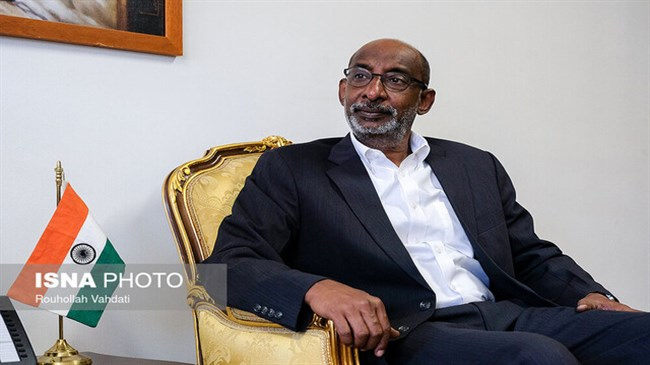Ambassador: SPV for trade between India, Iran fully operational

The Bilateral Payment Arrangement for trade between Iran and India, called the special purpose vehicle (SPV), is fully operational, said Indian Ambassador to Iran Gaddam Dharmendra.
Speaking in an exclusive interview with ISNA, he added the primary purpose of the SPV is to settle trade transactions between the two states.
Excerpts of the interview follow:
Q: Given the close economic relationship between Iran and India, what is the Indian government’s approach toward unilateral US sanctions against Iran?
A: Both Iran and India are large, developing economies with solid fundamentals. Both countries are benefiting from their respective demographic advantages. A young and aspirational population in both countries offers enormous market expansion potential and prospects for trade diversification. Today, Iran’s GDP stands at $450 billion while India is a $3 trillion economy. At present, India-Iran bilateral trade stands at more than $17 billion (2018-19). This is an increase of 25 percent. I see our economic partnership as being on a positive trajectory. This has been reinforced by the commitment of both sides at the highest level to further strengthen our age-old, historical relations and to bring these in line with the needs of both countries in the 21st century. I am confident that our bilateral trade will increase to $20 billion. This confidence is founded on our strong people-to-people contacts and burgeoning bilateral relations.
Since the implementation of the Chabahar Agreement, how much investment has been done and what are the figures of the volume of cargo traffic?
The Indian government has extended a credit line of $150 million for the development of the Chabahar port and $85 million for procurement of necessary port equipment. These commitments are presently in the process of being implemented.
The volume of cargo traffic has been satisfactory. As of July 2019, some 3,300 TEUs (twenty-foot equivalent unit) have been handled by the Shahid Beheshti port. Since February 2019, the trade has been mainly between Afghanistan, Iran and India. Both India and Iran are committed to the development of Afghanistan. The main cargo is livestock, food grains and other essential items such as sugar. All three countries are committed to increasing their trade exchanges and trade traffic. I feel that we need to better market the benefits of Chabahar port by disseminating information to users, viz., traders, shippers and others.
How much is the volume of trade between Iran and India and what is the perspective for boosting trade in the future? Have sanctions affected the volume of trade between Iran and India?
India-Iran trade presently stands at more than $17 billion. We saw a rise of more than 25 percent in bilateral trade as compared to last year. We are working with Iranian entities such as the country’s chambers of commerce to explore ways to further boost our trade. This includes diversification of the commodity basket being transacted between the two countries. There is substantial demand in India for Iranian fruits, almonds, walnuts, pistachios, dates and saffron. For Iranian traders, we wish to attract their interest and get them to consider India’s manufactures, which are obviously highly competitive both in terms of price and quality.
To what extent has the rupee-rial mechanism been operationalized and how can India contribute to easing the pressure of US sanctions on Iran?
The Bilateral Payment Arrangement is fully operational and its primary purpose is the settlement of trade transactions. Recently, an Iranian banking delegation was in New Delhi to explore ways to make the SPV more effective. Our effort has been to diversify our bilateral trade, with a view to enhancing, diversifying and growing at a faster momentum. We are mindful of the current challenges and hurdles being posed by the current circumstances but we are committed to our bilateral relations with Iran, which is an important neighbor and regional partner.
What are the plans to increase non-oil trade?
We hold regular bilateral discussions with Iran and explore ways to increase our bilateral trade and rate of investments. These efforts have resulted in an increase in non-oil trade. Commodities like Basmati rice, soybean meal, black tea and cane sugar are seeing an upward trend. Both sides have been engaged in discussions to finalize a bilateral investment treaty (BIT) and a preferential trade agreement (PTA). These discussions remain ongoing.
On tourism, what facilities does India provide to Iranian nationals for visiting India? How do people of India view tourism capacities of Iran?
The India-Iran millennia-old relationship is founded on strong people-to-people contact, exchange of ideas and traditions, and cultural commonalities. Ties and exchanges between our peoples have been ongoing since time immemorial. These are not some 200-300 years old but date back millennia. If you travel in India, you will find that these relations are extensively documented and reflected in our common culture and shared heritage.
Today, the same urges remain between our people. The introduction of e-Visa facility by both countries has greatly facilitated the objective of deepening these age-old ties. Several thousands of Indians travel to Iran for purposes of tourism and for ziarat (pilgrimage) to Mashhad and Qom.
Source: Iran Daily

